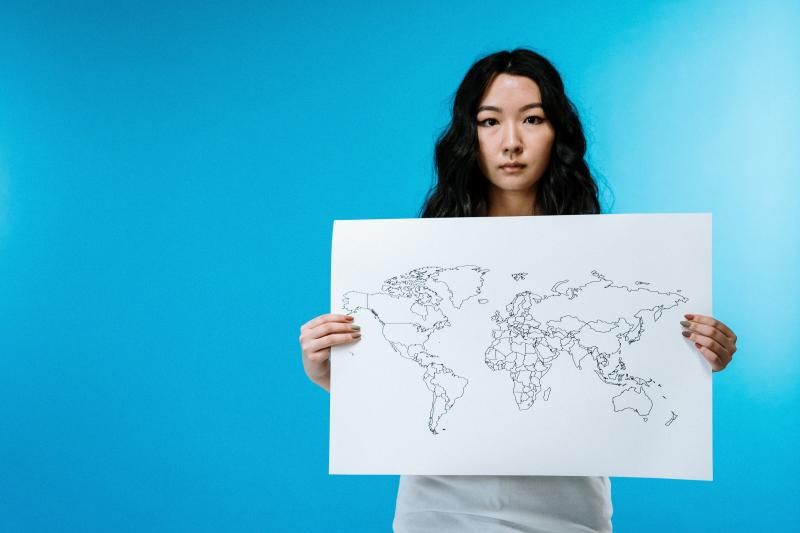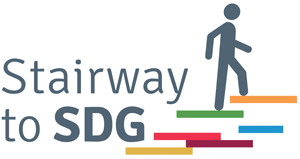Introduction

Women holding the world map (By cottonbro from pexels.com)
Gender is one of the dimensions of a person's identity and depends on the values, expectations, aspirations, appearances, behaviors and opportunities that differ in each context.
Cultural diversity characterizes local and global communities, bringing greater richness to societies, but also some challenges. In some situations, social and cultural norms can perpetuate, justify and strengthen inequalities and even situations of discrimination, namely gender discrimination which is a violation of human rights.
The first part of this session, aims to get participants to reflect on the fact that social and cultural norms and values may differ between communities, regions and countries and that it is important to listen and understand each culture.
However, considering that in some situations these social norms may call into question some fundamental values, the second part of the session presents a dilemma on gender equality, considering the example of multinational organizations. In this part, participants are invited to reflect on the following dilemma through the analysis of case studies: "What should a company do when its internal policies prohibit gender discrimination and promote gender equality, yet local cultural, legal or business norms permit and promote discrimination against women within some of the countries where it operates?" Through case studies, participants will reflect on the responsible actions that organisations can promote to address this issue.
Learning Objectives
- The learner understands levels of gender equality within their own country and culture in comparison to global norms (while respecting cultural sensitivity), including the intersectionality of gender with other social categories such as ability, religion
- The learner is able to recognize and question the traditional perception of gender roles in a critical approach, while respecting cultural sensitivity.
- The learner is able to feel empathy and solidarity with those who differ from personal or community gender expectations and roles.
- The learner is able to observe and identify gender discrimination.
- Normative competency
- Critical thinking competency
- Collaboration competency
Instructions
Step 1) Introduction (10 minutes)
- Start the session explaining the scope of the project or the educational process in question. The SDG 5 refers to gender equality – show the short video to introduce the SDG from resources section.
- Briefly introduce the SDG through a short introductory reflection based on the vídeo:
Women and girls systematically experience situations of discrimination and inequality around the world, with one in three women having suffered some form of violence. Gender equality is a fundamental right, however in some cultures some social norms allow these types of situations to occur. In the particular case of multinational companies, a first step must be to understand the culture in which they operate and then identify some actions in order to promote gender equality.
Ask students to draw a circle in their notebook. Then ask them to show the circle. Some people will make a larger circle, some smaller, some in the middle of the sheet, others in the corner of the sheet. In other words, each of us has different understandings and for everyone to make an exactly equal circle, you would need more information and the opportunity to ask questions.
We will now hear a story related to this and how the same reality can lead to different perceptions, especially when we are facing different cultures.
Step 2) 2 visions for 1 reality (30 minutes)
1. Explains the story of Xavier and Tabarlis: the first one lives on Planet Earth and went to visit another planet called Glorbuld, where he was hosted by Tabarlis. When Xavier is back home, he writes a letter to his friend Vincent to share his experience. On the other hand, Tabarlis writes a letter to his friend Verlias and explains what happened with the group of students from Planet Earth that they welcomed in Glorbuld.
2. Distribute one piece of paper to each student (up to 10). Make sure each piece has a number behind to keep the order of the story.
3. Ask each student to read out loud the story on his/her paper, starting with number 1 of Tabarlis’ letter and then number 1 of Xavier’s letter, and so on. The objective is to compare immediately both perceptions of the same moments (e.g. the arrival).
4. When all the participants have finished reading the story, you can facilitate a debriefing. Make sure to point out all the misunderstandings, prejudices and judgements in the story that can endanger or hurt the relationship. The students should understand that we all have a different representation of the same reality, based on our experience, our culture, the context, and our own perception of life. It is a kind of personal "glasses" through which we see and understand the world. These representations then directly influence our encounter with the other. When meeting somebody for the first time, if prejudices are identified, we can try to go beyond them to establish a relationship that goes beyond the stereotypes conveyed by our society. To do this, it is essential to know how to "decenter", that is to say, to identify our representations, what glasses enable us to see the world, and take the necessary distance to change, have a different perception of things, and thus transform the vision that one can have on the other.
Step 3) Gender Equality Dilemma (60 minutes)
However, in some situations it may not be easy for one person or an organization to put itself in the other's place when human rights violations are at stake. Let's consider an example of a Multinational Company that operates in several different countries and is faced with the following dilemma on gender equality:
"What should a company do when its internal policies prohibit gender discrimination and promote gender equality, yet local cultural, legal or business norms permit and promote discrimination against women within some of the countries where it operates?"
To answer this question, divide the participants into four groups to analyze and present a case study. They must answer the following questions:
- Who is involved?
- What is the dilemma?
- What have companies developed to face this challenge?
- What is the impact and results obtained?
- What is your opinion of this dilemma?
- What other types of initiatives do you think the company can create to face this dilemma?
Each group presents its case study.
Step 4) Conclusion (10 minutes)
Conclude the session by systematizing some dilemmas that may arise in terms of gender equality and some examples to answer them. End by highlighting the role of each person for not perpetuating situations of gender discrimination in the various spheres of life.
- CALL TO ACTION 1
Search for an international company near to where you live. Research the gender equality practices promoted by the company (e.g. you can look for this information in the sustainability report, website,...). Prepare a script for an interview with the help of a tutor to collect information about the sustainable practices of the company, particularly focus on gender equality. Attempts to schedule an interview with the representative of the company, explaining its objectives. Prepare an article for the school newspaper based on this interview.
- CALL TO ACTION 2
Ask students to collect information on corporate responsibility practices, particularly focused on promoting gender equality in order to raise awareness for the fact that consumption of goods and services are also an act of citizenship and that they can choose to support companies with these types of concerns in order to promote sustainable production and consumption. Based on this activity you can make an online awareness campaign about gender equality with good and bad gender equality examples by local, national or worldwide companies. If possible, you can try to establish partnerships with associations that promote ethical values to disseminate your message. Ask a tutor to support you in the development of the awareness campaign.
Notes for Educators
Estimated total duration: 1 hour and 50 minutes + Call to Action
Preparation
- There is no limit for the number of participants
- Prepare the paragraphs of the two stories to distribute for the students
- You can use other case studies to address this topic
Variations
As an alternative to the case studies which presents good practices to address gender equality dilemmas by companies, you can show the other side of the coin, analysing news about discrimination and violence practices by multinational corporations, but also from UN Peacekeepers, NGOs, among others, reflecting on the consequences of thee situations and how they can be unveiled and reported.
Tips for Educators
- Always contextualize how this activity can be useful for their personal experience abroad.
- The first activity allows the students to realize that our feelings are guided by our experience and our culture, and that if we do not go beyond these feelings, we can miss the reality and the discovery of the other.
Further Information
What is the dilemma?
Women represent an important group of potential employees for multinational corporations (MNCs) that choose to expand their operations in emerging markets. Yet, businesses are often faced with a dilemma when operating in countries where women and girls face legal, societal, cultural and religious discrimination. How can responsible multinational companies address gender discrimination in countries where the rights of women and girls are not adequately protected and respected? A point of departure might be ensuring respect for international standards in relation to discrimination and embedding them into corporate policy. However, following international human rights law pertaining to gender equality in countries where there is entrenched discrimination could have serious implications.
One example would be a company operating in a country that prohibits women from working in certain sectors. If the company hires women in these sectors, it could be prosecuted for breaching national law. If it does not, it would breach human rights principles, which protect women from all forms of discrimination. When faced with this dilemma, a company could simply choose to not operate in such countries. However, often this is not commercially viable and will not assist women living in the country who could be employed in alternative positions, thereby allowing them the right to earn a living.
Whilst this is an extreme example of the dilemma, in certain countries a company will have to address gender discrimination that is far more hidden. In many emerging markets and developing countries, gender-based discrimination is embedded in culture and is not necessarily opposed by the majority of women. As well as experiencing gender-based discrimination in their everyday lives, women face many forms of such discrimination in the workplace. This can include, but is not limited to: sexual harassment; gender pay gaps; pregnancy discrimination; inflexible working hours for working mothers; and entrenched gender stereotypes that prevent career progression.
A company that wishes to address these challenges responsibly should consider resolving these issues by breaking down the gender barriers that have given rise to discrimination in the first place. For example, businesses may choose to promote women's access to senior management roles in countries where cultural and societal attitudes inhibit women from achieving such positions and where institutional discrimination is prevalent. Placing women in such roles can help dismantle the stereotype that women are incapable of holding a management position.
Source
- http://intercultural-learning.eu/Portfolio-Item/2-visions-for-1-reality/
- https://hrbdf.org/dilemmas/Gender/#.YA707ej7TIV







